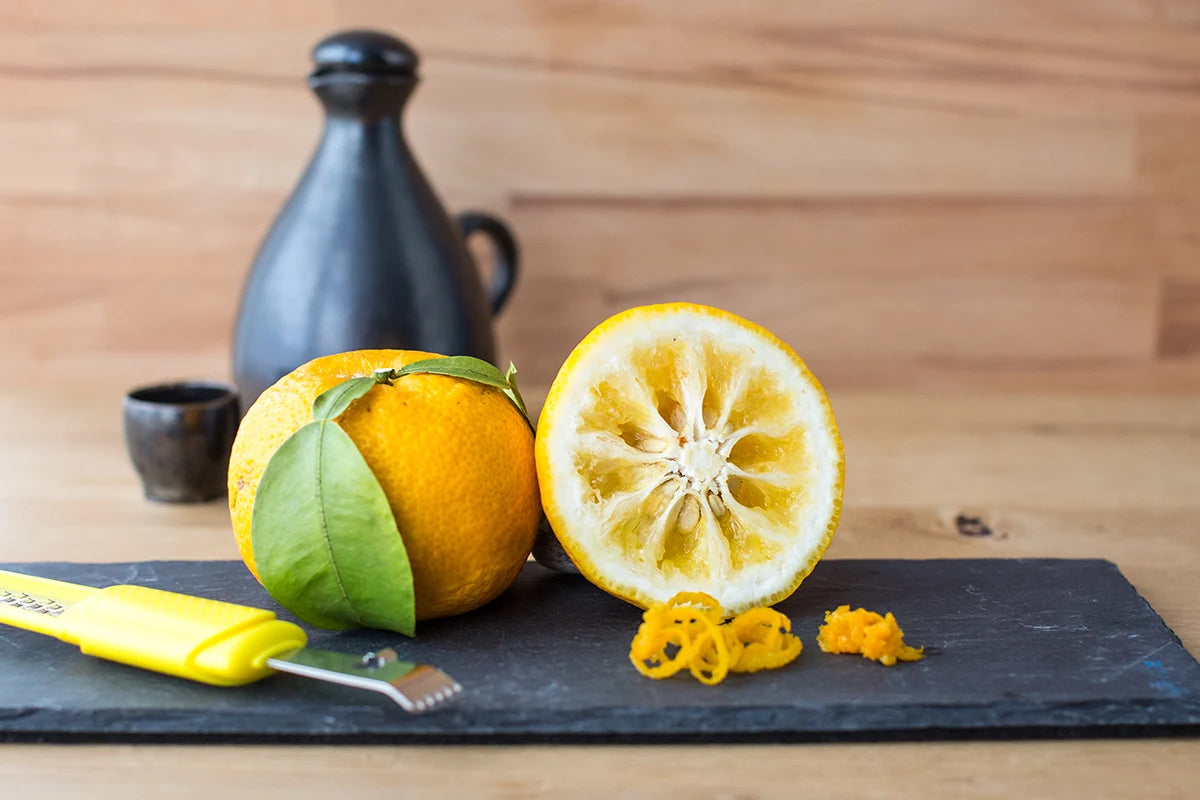
Yuzu, often called the ‘queen of citrus', is the best-known Japanese citrus fruit. With its powerfully aromatic taste, yuzu holds distinctive notes of many familiar citruses - lemon, mandarin and grapefruit - yet remains entirely unique.
In this article, we'll go into what Japanese yuzu is, how you can plant and grow it, and how to use it in authentic Japanese cooking. Read on to find out more!
What is the Japanese Yuzu Fruit?
Yuzu is a highly aromatic citrus, delivering a complex blend of mandarin, grapefruit and lemon notes. Originating in central China, the fruit was introduced to Japan during the Tang dynasty.
The yuzu tree is a hybridisation of a sour mandarin and a lemon, like ichang papaeda. It is from the ichang papaeda that the yuzu inherited its hardy ability to withstand cold temperatures.
The fruit's flavour is tart, resembling that of a grapefruit with mandarin orange overtones, and its peel has a unique, fragrant aroma. The size of the yuzu ranges between that of a tangerine and a grapefruit, and it has a bumpy outer rind that is either yellow or green depending on the degree of ripeness.
Yuzu fruits, which are very aromatic, typically contain a large number of seeds.

What is so special about yuzu?
Yuzu's uniqueness lies in its exceptional aromatic quality, unlike any other citrus.
Its scent is often described as a harmonious blend of grapefruit, mandarin, and a hint of pine, making it a desirable ingredient in both culinary and cosmetic industries.
In addition to its rich fragrance, yuzu possesses a tart flavour with subtle sweetness, an attribute that makes it versatile in various dishes. Its high acidity allows it to maintain its distinct flavour, even after cooking or baking.
Yuzu is loaded with vitamin C, boasting three times the amount commonly found in lemons, increasing its appeal as a health-enhancing fruit.
What does yuzu taste like?
The skin of the fresh yuzu fruit carries a powerful hit of citrus with a striking, floral aroma.
Its wonderfully tart zest is a staple of Japanese cuisine, and is used to flavour ponzus, soy sauces, miso, honey and chilli paste - as well as yuzu tea, or alcoholic drinks such as a yuzu sour.
European chefs have also embraced its famously tart juice in dishes as wide ranging as fish and white meat, to sorbets, ice creams and cheesecakes. Yuzu juice and zest are also big hits with the cocktail crowd, and a yuzu gin & tonic tastes like discovering the drink all over again!
Yuzu combines spectacularly well with cream-based desserts, sorbet, makes wonderful jam, candied or chocolate peel, and adds a fantastic burst of powerful citrus to cocktails and sparkling water.
When the fruit is unripe, green and rock-hard, yuzu peel can be grated and used in wonderful garnishes for fish, soups or salad dressings. Yuzu is also used to make yuzu kosho: a spicy fermented paste made with yuzu zest, chillies and salt.

Yuzu products and their uses
If you're looking for easy ways to infuse the unbeatable flavour of yuzu in your cooking, we've got an incredible collection and range of products just for you at The Wasabi Company.
Spice lovers go mad for yuzu kosho and yuzu chilli sauce, while others prefer a more subtle approach with delicately flavoured yuzu noodles or a umami yuzu miso.
If yuzu is one flavour you can't get enough of, then exploring these products is an absolute must!
Try the Yuzu Collections
The Yuzu Taster Collection
Dive into the sensational flavour of the famous Japanese citrus with The Yuzu Taster Collection.
The collection contains Yuzu Juice - which is so strongly flavoured that just a few drops will flavour a dressing or marinade, and makes a spectacularly refreshing drink when mixed with sparkling water or gin and tonic.
Miso With Yuzu, also included in the collection, is a delicious twist on a classic miso. Combining the umami-richness of fermented barley, the aromatic and tangy notes of yuzu citrus, and a touch of nutty sesame, this product results in a truly remarkable paste bursting with flavour.
Finally, the Taster Collection contains Candied Yuzu Peel. The floral yuzu peel is a delicious treat on its own, or eaten with fine chocolate, especially truffles!

The Gourmet Yuzu Collection
The magnificent seven products included in The Gourmet Yuzu Collection will give any yuzu lover an almighty fix of its wonderful flavour. An amazing gift for friends and family, or for any foodie in your life, this collection will start a new yuzu, and Japanese food obsession.
Along with the products of The Yuzu Taster Collection, the Gourmet Collection also includes Yuzu Mayonnaise, Yuzu Mustard, Namashibori Yuzu Ponzu, and Green Yuzu Kosho.
Yuzu Mayonnaise is an original, zesty dip, with the beautiful natural flavours of fresh yuzu fruits.
The 'clever combination' of Yuzu Mustard is delightfully tangy and unique, pairing especially well with cheese, fish, and white meats.
Namashibori Yuzu Ponzu is a traditional, authentic ponzu sauce, packed with the complex flavour of yuzu.
Zingy Green Yuzu Kosho livens up any dish! This classic Japanese condiment is packed with fresh yuzu and exciting chilli heat.
Yuzu Mustard & Yuzu Mayonnaise Twin Pack
This Yuzu Mustard and Yuzu Mayonnaise Twin Pack is the perfect introduction to the complex, unique flavours of yuzu with delightful combinations. These all-natural condiments, filled with big Japanese flavours, can innovate any dish and surprise your tastebuds.
Planting and growing your own yuzu at home
If you're interested in starting the exciting journey of planting and growing your own yuzu - you're in for a wonderful adventure!
At The Wasabi Company, we have a range of citrus trees and plants, including two options for hardy and non-hardy Yuzu Trees.
Read below to find out more about planting, caring for your yuzu plant, and harvesting its fruit.
Planting
Outdoors, in a sunny, south-facing, sheltered spot is desirable for planting. Acidic soils are preferable, and clay soils should be mixed with sand to allow for good drainage. Mounding the earth above the soil level is recommended in these conditions. In dry conditions, watering once or twice weekly is preferable to little and often. A summer mulch will help maintain moisture and reduce the risk of the roots drying out. Water logging is the most common ailment in the UK climate, so please follow the drainage advice above and prevent the tree from sitting in water.
In containers, use free draining compost, and additional perlite or hardwood bark will improve drainage if the compost does not already contain these. Irrigation should be controlled to maintain the compost moist and never saturated. Re-pot every 1-2 years, increasing the size of the pot each time. If you choose to move your tree in winter, remember to use a light pot. Raise the base of the pot above the surrounding ground to allow for free drainage of any excess water.

Caring for your plant
A controlled-release, nitrogen-rich citrus fertiliser applied in spring will support growth, liquid fertilisers should be applied in low strengths little and often to prevent excessive levels.
The most likely pest attack would come from aphids or mites. Encourage natural predators like ladybirds, lacewings and spiders. If evidence of these pests is seen, a spray bottle filled with water and a couple of drops of mild dish detergent will usually deter them. Keep trees dust-free (mites love dust) by gently rinsing the leaves with a very mild soap, or rinsing outdoor trees with a hose every couple of weeks.
All citrus trees require a period of nighttime temperatures below 12ºC for optimum spring flowering. If flowering is prolific in the first two years, it is recommended to remove some of the fruits when very small so the tree is not overburdened. A first and second-year harvest of 6-12 fruits is considered sustainable.
Be warned - yuzu trees wear their hardiness on the outside, sporting sharp thorns that will make themselves known if not handled with care. These can be removed if they are a hazard.
Trees may sprout shoots below the graft, and these should be removed as soon they are observed.
Harvesting
Highly fragrant, small white flowers appear with the spring, and the fruit is ready to harvest in October – December for a seasonally citrus lift to Christmas and the New Year.
Pick from the tree when the skin is a bright yellow. Dark spots or stains on the skin are normal and a sign of ripeness. Far from being rarely eaten, any early fallers can be used when unripe for an extra tart yuzu juice. The zest of both ripe and unripe yuzu is added to soups, dressing, and drinks and is used as a topping to sushi and fish. If you have a bumper harvest, yuzu freezes whole with excellent results for both the juice and the zest.
Buy Japanese ingredients at The Wasabi Company
At The Wasabi Company, we have a variety of fresh exotic fruits available seasonally, offering chefs and home cooks the opportunity to sample new flavours without relying on low-quality imports.

